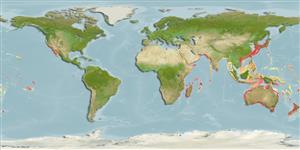>
Scombriformes (Mackerels) >
Scombridae (Mackerels, tunas, bonitos) > Scombrinae
Etymology: Scomber: Greek, skombros = tunny or mackerel, 1623 (Ref. 45335).
More on author: Cuvier.
Environment: milieu / climate zone / depth range / distribution range
ນິເວດວິທະຍາ
ສັດທະເລ; ປາທີ່ມີການເຄື່ອນຍ້າຍໃນສະເພາະມາະຫາສະມຸດ (Ref. 51243); ລະດັບຄວາມເລິກ 87 - 200 m (Ref. 9563). Subtropical; 43°N - 50°S, 32°E - 110°W (Ref. 168)
Indo-West Pacific: Red Sea, Persian Gulf; from Japan, south to Australia and New Zealand. Eastern Pacific: Hawaii and off Mexico (Socorro Island).
ຂະໜາດ / ນ້ຳໜັກ / Age
Maturity: Lm ? range ? - ? cm
Max length : 44.0 cm FL ຕົວຜູ້/ບໍ່ມີເພດ; (Ref. 40637); common length : 30.0 cm FL ຕົວຜູ້/ບໍ່ມີເພດ; (Ref. 168); ນ້ຳໜັກສູງສຸດທີ່ເຄຍຈັດພີມມາ: 1.4 kg (Ref. 40637)
ຄີ (ໜາມ)ແຂງຢູ່ຫຼັງປາ (ທັງໝົດ): 10 - 13; ຄີຫຼັງຂອງປາ (ຄີອ່ອນ) (ທັງໝົດ): 12; ຄີ(ໜາມ) ແຂງຢູ່ຄີກົ້ນປາ
ກຸ່ມປາກະດູກແຂງ
ຄວາມຖີ່ຂອງກຸ່ມຖ່າຍທອດພັນ
ປາທີ່ມີການເຄື່ອນຍ້າຍຈາກທະເລໄປຫານ້ຳຈືດ ແລະນ້ຳຈືດຫາທະເລ
ປາທີ່ມີການເຄື່ອນຍ້າຍຈາກທະເລແລະໄປໄຂ່ຢູ່ນ້ຳຈືດ
ຄີກົ້ນຂອງປາ
ສັດທີ່ມີກະດູກສັນຫັຼງ
ການຖ່າຍທອດທາງກຳມະພັນຈາກພໍ່ແມ່ຫາລູກ 0; ຄີກົ້ນຂອງປາ: 12; ສັດທີ່ມີກະດູກສັນຫຼັງ: 31. No well developed corselet but body covered with rather small scales. Palatine narrow. Anal fin origin clearly more posterior than that of second dorsal fin. Anal fin spine independent from anal fin. Swim bladder present. Snout pointed. Interpelvic process small and single. Back with narrow oblique lines which zigzag and undulate; the belly is pearly white and marked with thin, wavy broken lines.
Occurs in coastal waters (Ref. 9340) and also in oceanic waters (Ref. 9563). Minimum depth reported at 87 m (Ref. 58489); fishing depths to 265 m (cited in Ref. 58302). Schooling by size which may include jack mackerels and Pacific sardines. They are plankton feeders filtering copepods and other crustaceans, but adults also feed on small fish and squids. Also caught with encircling nets (Ref. 9340). Marketed fresh, dried-salted, smoked, canned and frozen (Ref. 9987).
Life cycle and mating behavior
ການຈະເລີນເຕັມໄວ | ການສືບພັນ | ການວາງໄຂ່ | ໄຂ່ | ຄວາມດົກຂອງໄຂ່ປາ | ຕົວອ່ອນ
Collette, B.B. and C.E. Nauen, 1983. FAO Species Catalogue. Vol. 2. Scombrids of the world. An annotated and illustrated catalogue of tunas, mackerels, bonitos and related species known to date. Rome: FAO. FAO Fish. Synop. 125(2):137 p. (Ref. 168)
IUCN Red List Status (Ref. 130435)
Threat to humans
Harmless
Human uses
ການປະມົງ: ເປັນສີນຄ້າ; ຊະນິດປາທີ່ຖືກນຳໃຊ້ເຂົ້າໃນການຫາເພື່ອເປັນເກມກິລາ: ແມ່ນ; ເຍື່ອ: usually
ຂໍ້ມູນຕື່ມອີກ
ຊື່ສາມັນຄຳສັບຄ້າຍຄືກັນການເຜົາໃໝ້ພະລັງງານໂດຍປ່ຽນທາດອາຫານໃນຮ່າງກາຍໃຫ້ກາຍເປັນຊີ້ນແລະໜັງຜູ້ລ້າການສຶກສາຜົນກະທົບຂອງສານຜິດທີ່ມີຜົນກະທົບຕໍ່ລະບົບນິເວດການສືບພັນການຈະເລີນເຕັມໄວການວາງໄຂ່ການສັງລວມການວາງໄຂ່ຄວາມດົກຂອງໄຂ່ປາໄຂ່Egg development
ເຄື່ອງມື
Special reports
Download XML
ແຫຼ່ງອີນເຕີເນັດ
Estimates based on models
Preferred temperature (Ref.
123201): 10.8 - 24.3, mean 18.7 °C (based on 185 cells).
Phylogenetic diversity index (Ref.
82804): PD
50 = 0.5625 [Uniqueness, from 0.5 = low to 2.0 = high].
Bayesian length-weight: a=0.00912 (0.00799 - 0.01041), b=3.05 (3.01 - 3.09), in cm total length, based on LWR estimates for this species (Ref.
93245).
ຊັ້ນເຂດຮ້ອນ (Ref.
69278): 4.2 ±0.5 se; based on diet studies.
ຄວາມຢືດຢຸ່ນ (Ref.
120179): ຂະໜາດກາງ, ປະຊາກອນຕຳ່ສຸດທີ່ໃຊ້ເວລາສອງເທົ່າ 1.4 - 4.4 ປີ (K=0.28).
Prior r = 0.57, 95% CL = 0.38 - 0.86, Based on 2 stock assessments.
Fishing Vulnerability (Ref.
59153): Moderate vulnerability (43 of 100).
Climate Vulnerability (Ref.
125649): Low to moderate vulnerability (30 of 100).
Nutrients (Ref.
124155): Calcium = 52.1 [17.4, 129.4] mg/100g; Iron = 2 [1, 5] mg/100g; Protein = 21 [20, 22] %; Omega3 = 0.392 [0.257, 0.600] g/100g; Selenium = 74.3 [27.5, 192.3] μg/100g; VitaminA = 24.7 [5.9, 109.4] μg/100g; Zinc = 0.822 [0.487, 1.377] mg/100g (wet weight);
